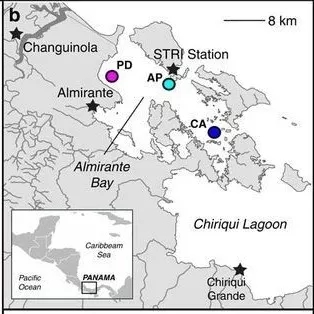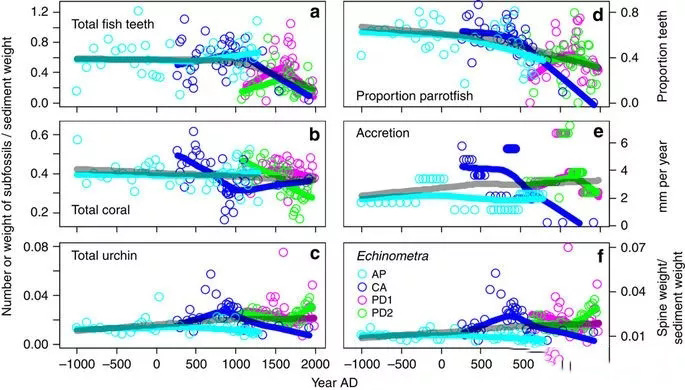Caribbean reefs have been transformed to be algal-dominated in recent decades, but due to the lack of quantitative ecological data prior to large-scale human impacts, the specific mechanisms of change have not been identified. In order to understand the relationship between the recent decline of herbivores and coral loss, we produced a high-resolution 3000-year high-resolution coral reef accumulation rate based on the analysis of sediments, fish, coral and sea urchin fossil remains in the Caribbean core of Panama. and related records of the abundance of herbivores (sea urchins and parrotfish). It was found that at each sampling point, coral accumulation rates and declines in parrotfish populations began millennia ago. Our statistical test of direct causality using convergent cross-mapping showed that the number of parrotfish, rather than the number of sea urchins, determined reef accumulation rates. These conclusions identify the important role of parrotfish in maintaining coral-dominated reefs and the need for urgent restoration of parrotfish populations to ensure the continued existence of coral reefs.
Coral reef monitoring in the Caribbean began in 1970, when the reefs were dominated by staghorn corals, but into the 1980s, disease outbreaks led to mass mortality of staghorn corals and sea urchins; and coral bleaching in the late 1980s transformed Caribbean reefs It is dominated by macroalgae. Coral bleaching and disease are inseparable from the increase in sea temperature caused by global warming, and the overfishing of parrotfish is also an important reason for the growth of macroalgae.

Figure 1) Four coral reef fossil sampling sites in Bocas del Toro, Panama

Figure 2) Biological remains preserved in coral reef ore cores a. Comparison of parrotfish teeth with other types of animals b. Fragments of various coral skeletons c. Common sea urchin types

Fig. 3 Millennium trend of the abundance of the main fossil components of coral reefs and the accumulation rate of coral reefs
a. Fish teeth. b. Coral. c. Sea urchin d Ratio of parrotfish teeth to total teeth e Stacking rate of coral reefs
(reef accumulation in millimeters) f Echinacea
Teal: Airport sampling point. Blue: Adriana sampling site. Pink and green; Ponta Donato sampling site

Figure 4. Causal analysis of reef accumulation rates and parrotfish or coral abundance:
a Parrotfish relative abundance and coral reef accumulation rate; b Sea urchin abundance and coral reef accumulation rate
c Relative abundance of parrotfish and sea urchin abundance; d. Relative abundance of pontoliths and coral accumulation rate
From Figure 4, it can be found that the abundance of parrotfish is positively correlated with the accumulation rate of coral reefs, while the abundance of sea urchins has no correlation with the accumulation rate of coral reefs. The abundance of parrotfish is positively correlated with the abundance of long sea urchins
We analysed changes in coral reef communities in Bocas del Toro in the Caribbean over millennia and found that reefs have been influenced by fish for more than 2 centuries. The clear causal relationship between parrotfish abundance and reef accumulation rates suggests a lack of algal-eating fish on modern reefs. If parrotfish numbers are low, reef accumulation stops, so parrotfish hunting should be reduced.
Source: Nature